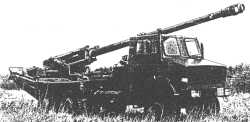The Gun - Mechanisation: Towed Field Artillery | ||
Recent DevelopmentsToday towing vehicles vary in power and capacity from the 1-tonne Landrover up to 6x6 tractors, depending on the equipments to be handled and the ammunition etc to be carried. The term 'limber' has been resurrected in the British service but it refers to a vehicle identical to its accompanying gun-towing vehicle except that it is designed solely to carry ammunition and other equipment but no detachment. Some modern towed field and medium artillery equipments are now fitted with Auxiliary Power Units (APU), a typical example being the 155-mm FH 70 (Field Howitzer 1970), a joint UK-German-Italian project taken into service in 1979. The APU, consisting principally of a 1800cc Volkswagen i/c engine, enables the gun to be moved short distances without the assistance of the tractor, eg to an alternative position, or into or out of the gun pit. In addition it provides hydraulic power for the service of the gun, eg opening or closing the trail legs when moving into or out of action. | ||
 |
FH70 with piece in travelling position towed by a 6x6 Foden tractor. Another vehicle, identical except for no detachment cabin, accompanies each gun. Designed solely for the carriage of ammunition and stores, it is called a 'limber'. | |
| FH70: |  | |
|
A more recent innovation is the French 155-mm 52-calibre gun mounted on a 6x6 Unimog chassis. Called the CAESAR (CAmion Equipe d'un Systeme d'Artillerie, ie truck fitted with an artillery system), it is an effort to make the 155-mm gun as mobile as its conventional SP counterpart but without the considerable expense of a tracked chassis. | ||
 | CAESAR - side view. The 'trail' legs, seen at the rear of the tray, are let down in action. | |
|
WL Ruffell, 1994 previous | index | next | History index | Home | ||